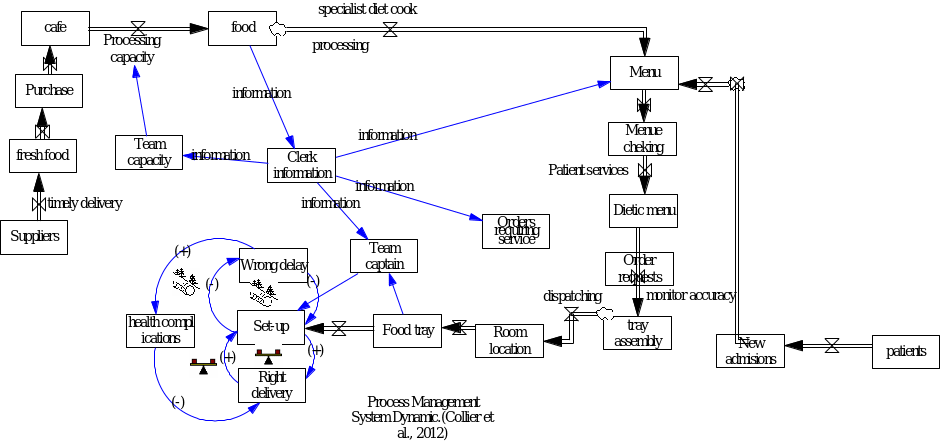Patient nursing plays a critical role in ensuring patients’ well-being in hospitals while battling illnesses. Given the complexity, uncertainty, and multidimensionality that characterize nursing food delivery and patient care, different modeling approaches should be employed to assess the causes and impacts of wrong food delivery to patients in various hospitals. This paper aims to explain how the system dynamics model could help solve food delivery problems and its dimensions in hospitals.

In food delivery operations, the system dynamics use help define the problem boundary using flows and stocks. It assists in identifying the sources of information that impact the flows of the delivery system in the hospitals. The dynamic determines the main feedback loops with the vital information and opportunity to make the required food delivery services. It defines the clerk as the critical sources of information. They have all the information about the patients, including their dietary menu, names, and rooms. If the clerk loses or misinterprets data about the patients, they are at risk of receiving the wrong food (Collier et al., 2012). It also explains that the captain’s set-up stage is vital in ensuring the correct food delivery. It states that when the captain puts the proper food with the right names and rooms, then wrong food delivery is solved.
The Problems Facing the Hospital’s Dietary Food Service
The hospital’s dietary food service department is experiencing a complex problem operation of wrong food tray delivery to patients. Consequently, there is a lack of attitude, quality care, culture and responsibility, service failures with high to low costs and much workload.
The Cost to the Hospital of a Minor Versus Major Service Upset or Failure?
The cost is a failure, delivering the wrong food to a patient may worsen the situation. Some patients may be allergic to certain types of food served to them and, in severe cases, may lead to death.
What does the Value Chain look like? Features of each Area with Examples of Opportunities for Errors at each Stage of the Value Chain

The dietary food department administrations start with raw materials and supplies, giving items such as refrigerated, non-refrigerated, or frozen materials and moderate utilities. In this chain, the providers might be utilizing old raw stuff and delivery once every week to the dietary office, giving an error opportunity. Cooking breakfast, lunch, and supper in the chain, may be tiresome and costly, therefore cooks may decide to preserve the leftovers at night to minimize wastage and workload, leading to an error. Subsequently, the interaction for order taking comes after cooking, it uses a halfway cycle for order taking, which may be wrong when taking the patient’s menu to the clerk leading to error opportunity. In the last assembly, the cooks put food on each patient’s plate on a huge pivoting oval track (Collier et al., 2012). The cooks may contaminate food when they forget to wash their hands when dealing with the food. Finally, there might be late order delivery to patients due to the many workloads that the employees have.
Who is Responsible for Quality?
The Dietary personnel in the food service department is responsible for the quality of food offered in the hospital
The Patient’s Wants and Needs, CBP Features, and Associated Processes
The patient’s wants are the dietary department being efficient and systematic with the plan of their framework without mix-up that may give the wrong food plate to the patient. On the other hand, the patient’s need is their eating regime prerequisites being satisfied by the dietary office.
Client Benefit Package (CBP) is a bunch of notable and elusive highlights that the client perceives, pays for, utilizes, or encounters. CBP additionally is a blend of merchandise and ventures arranged in a specific manner to offer some incentive to clients, which comprises essential products and services, combined with fringe merchandise as well as services. Value Creation Process focused on primary goods or services such as hospital operations and patient’s tray assembly. Support Process includes purchasing a good food production for the three primary groups: patients, employees, and visitors. General Management Process, including the services to deliver the patients tray, the clerical support inpatient services, and the dietary department.
Select a Process and Discuss how to Mistake Proof it and Improve Process Performance
The transformative cycle includes creating significant worth in terms of time, place, data, diversion, trade, or structure utility. The goal of the transformation measure is to yield output for a specific client or market portion. The client’s precise transformation measures are manufacture and assembled, where raw material is changed into actual merchandise. The dietary department’s lateness behavior of picking trays and menu orders in every case puts the general staff to worry about the accuracy of prescribed food diets for every patient. The administration should implement tray collection reforms at the dietary department to avoid putting doctors and nurses under pressure when there are late services. Consequently, the administration should transform and advance the menu to avoid keeping food for long in the fridge to minimize cost. The patients’ wellbeing should be a priority, and cohesive services must be given to them as required.
How do we Turn this Dietary Food Service around? Recommendations
I suggest an immediate meeting to create sign-offs for each key stage of the value chain, quality at the source, and more audits to reduce the opportunity for other similar errors. Ultimate actions may be a formal continuous improvement program, training, recognition, metrics, and motivation. Consequently, the dietary food administration should utilize more representatives to their specialty. It can potentially help prevent giving the wrong food to the wrong patient.
Reference
Collier, D. A., Collier, D. A., & Evans, J. R. (2012). Operations management. South-Western College Pub.